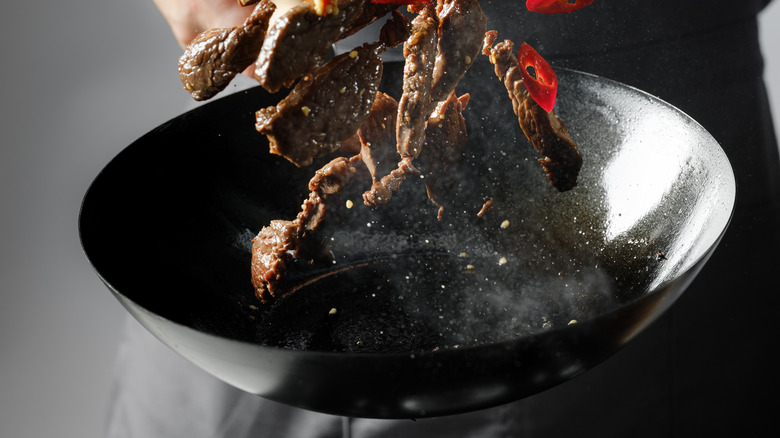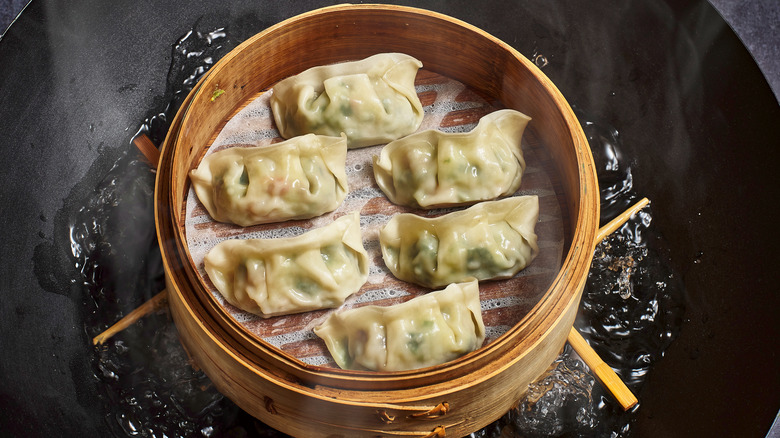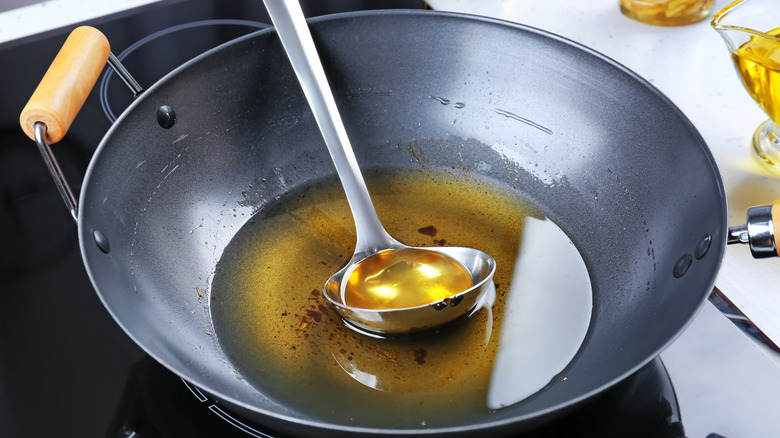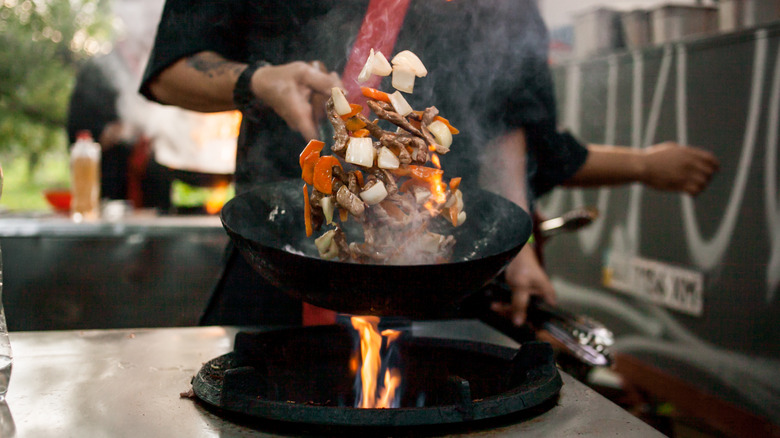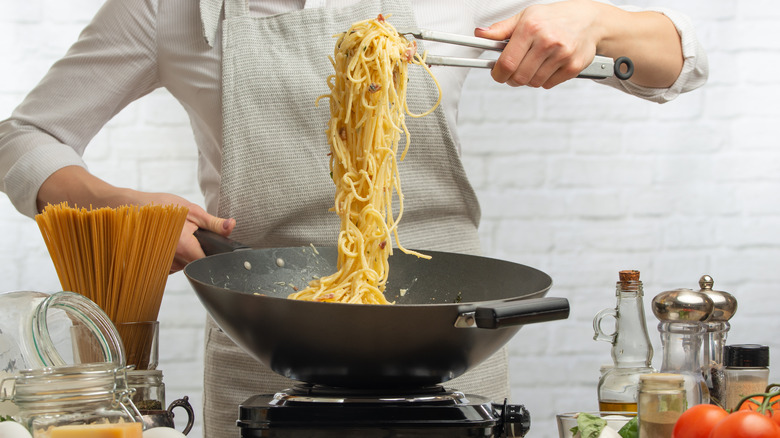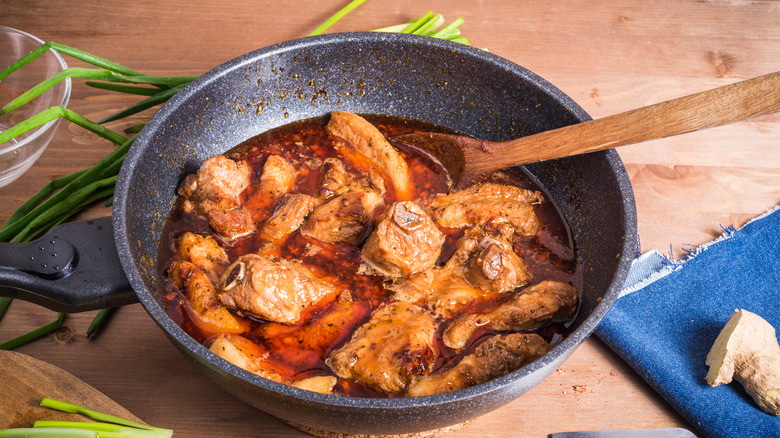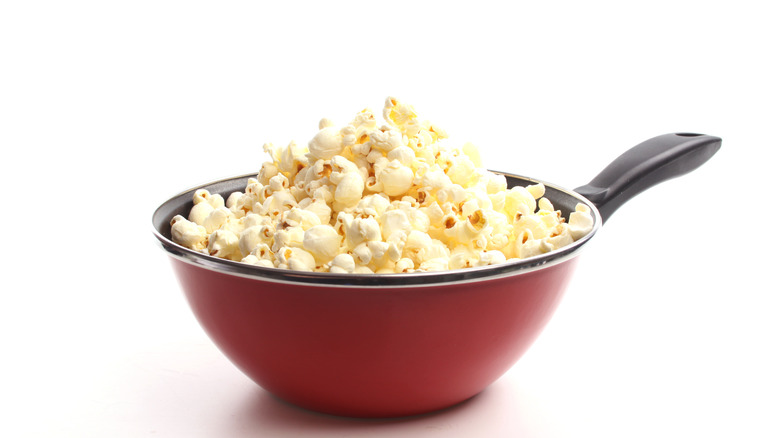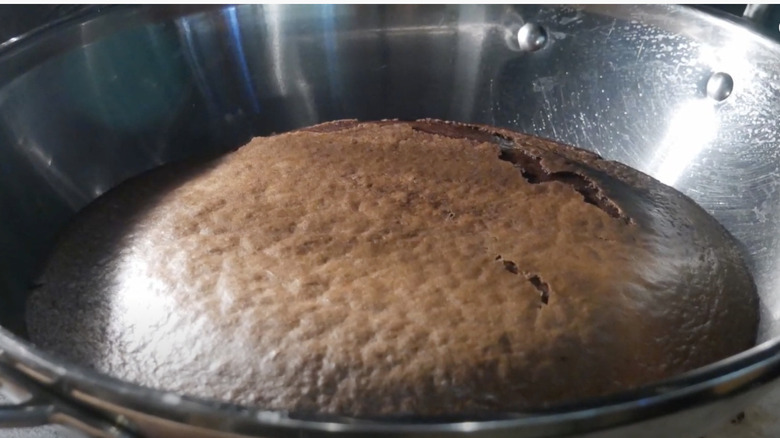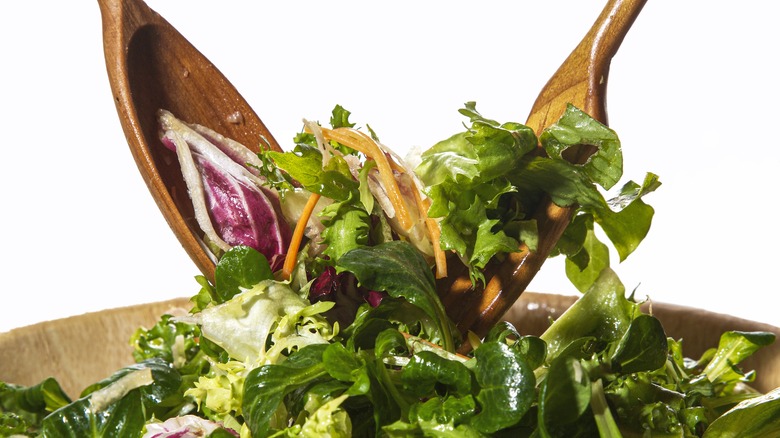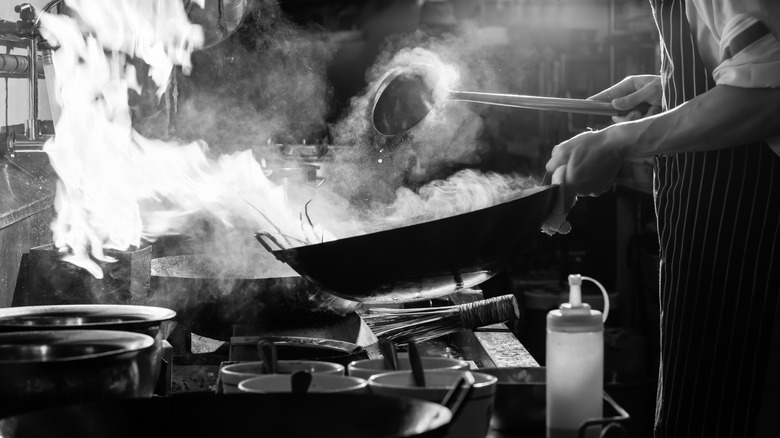The Absolute Best Uses For Your Wok
We're willing to bet that wok that's collecting dust in your kitchen cabinet is definitely not living up to its full culinary potential. There are so many cooking uses for this versatile pan, and you might not be taking advantage of all of them (via The Woks of Life). In fact, there are instances where the wok might be better than whatever go-to pan you're currently using for recipes in regular rotation in your kitchen. The bottom line is, woks aren't just good for stir frying (even though they are amazing at that too).
Keep reading to discover the eight top ways to utilize your wok (one of them includes making a full-on cake, believe it or not). You will no doubt learn some new kitchen tricks, and maybe get a little inspiration to bust out that dusty wok sooner rather than later. And if you are still figuring out what type of wok you want to buy so you can try all these uses out, it's important to consider the type of stove you have and what you cook the most often, as well as whether the non-stick versions that are available in most stores are worth it for wok cooking.
Steaming
Woks are an ideal vessel for steaming your favorite vegetables, dumplings, and other culinary staples like shellfish. The reason why woks are a clutch pan for steaming, as the cooking wizards at Serious Eats point out, is because almost any size steamer basket will fit inside because the wok's sides are sloped. You just have to make sure the diameter of the steamer (which can even be a disposable aluminum pie pan, inverted with holes poked in it) is less than that of the wok.
With steaming, the steam from the simmering water rises to cook the food, so the bottom of the wok will contain a few cups of water. The key is to keep an eye on the water amount and make sure the steaming process is wrapped up before all the water evaporates, otherwise the bottom of the wok might start to burn the bottom of the steamer, which could be especially problematic if you're using a bamboo basket.
Deep frying
Frying food in your own kitchen can be a precarious matter. Where's all that splatter gonna go, and what are you gonna do with the cooking oil when it's all said and done and everyone's in a coma from eating that fried chicken? Honestly, the wok helps mitigate a few of those pitfalls.
Per the kitchen experts at Made In, woks are clutch for frying, especially smaller items (beignets, French fries, mushrooms, cauliflower ... we could keep going), for a number of legit reasons. There is inherently less oil splatter when you fry in a wok because the high-sloped sides catch a lot of the sizzle. We love a good cast iron skillet, but it can't combat the popping grease quite like a wok. Woks require less oil than other frying vessels anyway due to their shape. Also, woks have a greater surface area, allowing you to fry more items at once, and shift them around pretty easily too.
All and all, the wok is an excellent tool for deep frying, so please don't pigeon hole it solely as a stir-frying pan — it's so much more than that. The only caveat is that non-stick woks are not recommended for deep frying (via The Woks of Life), or any high-heat cooking for that matter.
Stir frying
Perhaps the OG cooking use we all already know and love, woks are obviously a no-brainer when it comes to stir frying. One of the world's premier wok experts, Grace Young, spoke to Food & Wine about stir frying, and explained that the term is a bit of a misnomer since in reality you're sort of "tumbling" rather than "stirring" the food, and the process is more "searing" than a "frying." Regardless, the results are usually pretty delicious if you're looking for a uniform sear.
Stir frying in a wok is also just a super easy cooking method when you're having a lazy night where the thought of some elaborate, complicated recipe makes you want to run to your GrubHub app. Heat the oil in the wok, toss in the protein or vegetables, let everything sit untouched for a minute, then start stirring. Then you'll add in some broth or more liquid, stir, and cover for about a minute. Do one last stir with some garnish tossed in, and you've got the meal ready to go.
Finishing pasta
While you can technically boil water (it will get really hot, really fast) and cook pasta in a wok if you so desire, where the wok really shines is in a super simple pasta finishing technique (via Cuisine Fiend). If you heat or make pasta sauce in a small saucepan and then try to coat drained pasta that has been returned to its original boiling pot, you risk not being able to really enjoy every last drop of sauce, and there is also the splash factor. Mix everything in a separate bowl and you risk it getting cold.
So here's a fun pro trick: Make the pasta sauce in the wok, and after the pasta is boiled to al dente and then drained, empty it into the wok to toss with the sauce. This ensures the pasta is evenly coated and tossed in the warm sauce. There is less mess, too, since woks are basically built for tossing and stirring. This is definitely a fun and effective use for your wok on Italian dinner nights.
Braising
If you've got a dish that requires braising on your must-cook list, you can definitely enlist your wok for that too. According to James Beard-Award-winning Chicago chef Stephanie Izard, speaking with Made In Cookware, "... braising is when you cook low and slow in liquid." Izard further explains that the wok is a definite gem when it comes to braising, and an excellent tool for a 30- to 40-minute braise, especially with chicken thighs since they can withstand longer cooking times without getting too dry.
Of course specific instructions will vary per recipe, but in general it's recommended that you add vegetables and protein to the heated wok first, cook for a few minutes, then pour in the sauce or marinade, which you bring to a boil. Then immediately turn down to low heat so your dish is set for a nice, steady simmer. It's a one-stop shop for searing the meat and vegetables, then bringing that tasty liquid in to do its job flavoring everything via braise.
Popping popcorn
Everybody knows the least fun way to pop popcorn at home is in a bag in the microwave. You've probably repeatedly heard how easy it is to make popcorn on a stove, and the rumors are true! But what about popcorn by way of wok? It's also quite doable. The wok's sloped sides help facilitate the pooling of kernels and oil at the bottom and the popped corn making its way to the top. It's also possibly a bit easier than using a pot since it can withstand really high heat, you don't have to vigorously shake it as much throughout the popping process.
You just need some cooking oil, popcorn kernels, and salt (via Liete's Culinaria). Much like the process of making popcorn on the stove in a standard pot, you pour in the oil and a few kernels. Then place the lid on the wok and heat the kernels on a medium setting. Once the kernels start to pop, gently pour in the remaining ones, return the lid, crank the heat down a bit, and shake the wok continuously until the length of time between popping sound slows significantly. Immediately take the wok off the heat source and sprinkle the popcorn with salt. To prevent an excessive amount of grease splatter, line the inner side of the wok's lid with foil before commencing the popping process.
Baking a cake
While you can certainly always make your birthday (and other) cakes in traditional cake pans, if you want to have some fun with the cake shape, a wok is also a potential cake vessel. The key is to make sure the wok is oven-safe, so ideally a stainless steel wok with a stainless steel handle like the one used by popular YouTube channel host Wok with Tak. Tak also suggests spraying the wok with cooking spray and sprinkling it with flour prior to adding the cake batter. As always, it's advisable to let a cake cool completely before frosting it.
Again, the wok might never become your go-to method for baking a cake, but it would certainly be fun to try, and it's just nice to know it's yet another possible use for this versatile cookware. Also, who doesn't love a dome-shaped cake every now and then?
Tossing salads
If boots were made for walking, woks were made for tossing. The sloped sides keep liquids and solids of all kinds contained while you fold ingredients together, or while you aggressively stir to coat everything from veggies to pasta (via Serious Eats). The wok's shape and ability to take a whole lot of heat are just two of the many reasons why it's so versatile. So it's no wonder that a wok can also make for a great salad bowl or, if you don't want to set the wok in the middle of the table, just a great place to put together the salad and toss it with dressing before serving. That said, you'll have to be sure to wash your wok asap after this use, as the acidity of many salad dressings can harm your wok's protective sheen (via The Woks of Life).
In the mood for a warm salad? Cooking lettuce or other greens in a wok prior to incorporating other salad ingredients is a surprisingly delicious approach. We like this Stir-Fried Garlic Lettuce recipe, which can be enjoyed just as is, from wok expert Grace Young (via Epicurious).
Smoking meat
While it may not be the ideal choice for giant slabs of ribs or other large cuts of meat, the wok can be a good conduit for smoking. In fact, according to the chowhounds at Serious Eats, the wok offers more possibilities in terms of ingredients you can smoke with because you can more easily adjust the heat source under the bottom of the wok, as opposed to coals under a smoker or grill. You will need some heavy-duty aluminum foil as well as a cooking rack — and if you've got one that's round and nestles right into the wok, you're really in for some smoking success.
The smoking ingredients (which can range from dried herbs and spices to standard wood chips) go into the foil-covered wok base. The piece of foil should be large enough that the sides drape over the edges at least five inches. When the base ingredients start to yield smoke, the aforementioned cooking rack goes atop the wok and foil, the meat you are smoking goes onto the rack, then another piece of foil is placed over the top and sealed with the bottom layer of foil to create a tent for the meat. The cooking time will vary according to the wok-smoking recipe you use, but oftentimes smoking in a wok does require some post-smoke roasting too. Still, the wok is a fun tool to use if you're gunning for a smoky flavor for your wings but don't want to have to rope in a full-on grill or smoker situation.
